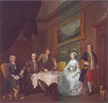We posed this and the other four key Great British Art Debate questions to our keen debate fiends over on facebook. Here are some of their thoughts:
I remember a version of this line being used by my history teacher backn in school – we need to learn about the past to understand the world of today… and yes, in a technical, academic sense this is true – the genesis of the values and ideas which shape our culture are a matter of historical investigation. But that is only one aspect of the way art can talk to the world of today; our own responses (what we like and don’t like) speak of today’s values, and I don’t think there’s any way around that. So thinking about the art of the past means keeping in play both these things – the historical record which the artwork is part of, which belongs to a bigger historical story which leads to today, and the way we respond to works themselves, and what that says about us.
– Martin Myrone, Tate Curator
I think a lot of modern artists can’t paint – they’d do well to take a few lessons from the old masters. Shouldn’t art involve skill as well as inspiration?
– EL, FacebookI think the art of the past represents a time when things seemed simple, when we valued craft and skill differently, and when it was clear what artists are supposed to do. Our relationship to the art of the past is vital to our understanding of ourselves and because of this I would say that the art of the past not only speaks about the world of today, it is a vital part of it.
– AB, Facebook
What do you think?








There is something remarkably the same about form, color, function, and thought in todays art and in art from our past. ~~~~~~~~~ It is (nearly) always humans who would appreciate art of the past and what it says about our world today. And that appreciation is….We humans haven’t changed. We still are born, learn, exchange tokens for energy for food and shelter, seek closeness with other humans and ultimately die. (the rest is simply detail). We are also still intrigued by all definitions of art and beauty. I think the art of the past reminds us that we still value culture and expression. And the art of today repeats those important values.
Yes and no. Artists from the past were of course as much human beings as the artists of today are. But the context of life of course changed. That’s exactly the reason why new artistic ideas are being developed and why new artistic forms are being invented. Simply because the art of the past can’t keep up with new realities.
I’m constantly amazed by the way that paintings that are often seen as just old fashioned can still speak to children in particular. After a discussion of Victorian narrative paintings with a class of 10 year olds, one pupil wrote: “I learned how lucky we are to be living such wonderful lives and those poor Victorian people had to work every second, every hour and every day.”
So on one hand art of the past reminds us of how we got to where we are and how different our lives are today, but on the other it shows us that despite how it seems on the surface nothing really changes. The four siblings in Hogarth’s ‘Graham Children’ seem stiff, stuffy and spoiled but when children step inside the painting and bring it to life they notice many qualities they recognise in themselves that haven’t changed at all including cheekiness, awkwardness and a sense of fun.
And from an artistic point of view, all artists were modern in their day and suffered the same struggles and insults as artists today. Constable, Turner and (my personal favourite) Gainsborough all broke the rules and revolutionised art in their own way. One of Constable’s reviewers wrote that his paintings looked “as if a plasterer had been at work”; sounds just like things you read about some artists today.
One defining factor of contemporary art is its undoubted influence from the art of our past. There is no denying that artworks today are heavily inspired by ageing masterpieces, and the connections between ‘old’ and ‘new’ artworks become increasingly prominant as we journey futher into the 21st Century.